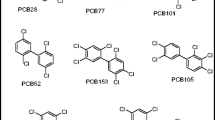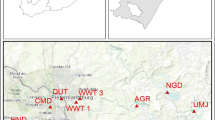Abstract
This study focuses on the sorption efficiency of porewater–sediment of eight selected polychlorinated biphenyls (PCBs) most monitored in the environment as recommended by the Environmental Protection Agency. Five river sediment samples were collected along the Umgeni River of KwaZulu-Natal province of South Africa that contained different soil contents. The Walkley–Black method was employed for the determination of soil organic matter in the sediments, while sediment mineralogy and morphology, as well as elemental composition, were evaluated using powder X-ray diffraction and scanning electron microscopy equipped with energy-disperse X-ray, respectively. The sorption studies between porewater and sediment systems were carried out using batch adsorption experiments. The results showed that sediment samples containing high clay and silt content (13.90%, 30.43% and 18.58%, 19.93%) (site AWW and IDI) have the highest sorption percentage between 65.86–89.81% and 61.39–70.43%, respectively, for all the PCBs, while sites IDO and BL with high sand content (86.29% and 85.20%) sorbed the least amount of PCBs (32.32–53.06% and 43.23–59.77%, respectively). Among the sediment physicochemical parameters, soil organic matter was observed to correlate positively and play an important role in the sorption of PCBs. Also, a decrease in the ratio of Si:(Al + Fe) was noticed to have a positive impact on the sorption of PCBs. This is the first study done on this river to critically evaluate the porewater–sediment distribution and transportation of PCBs. Sorption efficiency of sediments of known physicochemical properties similar to this study area can be predicted by the sorption results of the present study.




Similar content being viewed by others
References
Adeyinka GC, Moodley B (2019a) Kinetic and thermodynamic studies on partitioning of polychlorinated biphenyls (PCBs) between aqueous solution and modeled individual soil particle grain sizes. J Environ Sci 76:100–110
Adeyinka GC, Moodley B (2019b) Effect of aqueous concentration of humic acid on the sorption of polychlorinated biphenyls onto soil particle grain sizes. J Soils Sediments 19(3):1543–1553
Afghan BK, Chau ASY (1989) Analysis of trace organics in the aquatic environment. CRC Press, Boca Raton, pp 33–68
ATSDR, Toxicological Profile for Polychlorinated Biphenyls (2000) Atlanta (GA): US Department of Health and Human Services, Public Health Service, Agency for Toxic Substances and Disease Registry. http://www.atsdr.cdc.gov/ToxProfiles/tp17.pdf. Accessed 26 May 2018
Bailey GW, White JL (1970) Factors influencing the adsorption, desorption and movement of pesticides in soil. Residue Rev 82:29–92
Barakat AO, Kim M, Qian Y, Wade TL (2002) Organochlorine pesticides and PCBs residues in sediments of Alaxandria Harbour, Egypt. Mar Pollut Bull 44:1421–1434
Barhoumi B, LeMenach K, Dévier M-H, El megdiche Y, Hammami B, Ameur WB, Hassine SB, Cachot J, Budzinski H, Driss MR (2013) Distribution and ecological risk of polychlorinated biphenyls (PCBs) and organochlorine pesticides (OCPs) in surface sediments from the Bizerte lagoon, Tunisia. Environ Sci Pollut Res Int 21:6290–6302
Bi XH, Chu SG, Meng QY, Xu XB (2002) Movement and retention of polychlorinated biphenyls in a paddy field of WenTai area in China. Agric Ecosyst Environ 89(3):241–252
Breivik K, Sweetman A, Pacyna JM, Jones KC (2002) Towards a global historical emission inventory for selected PCB congeners—a mass balance approach 1. Global production and consumption. Sci Total Environ 290(1–3):181–198
Brownawell BJ, Farrington JW (1985) Partitioning of PCBs in marine sediments. In: Sigleo AC, Hattori A (eds) Marine and estuarine geochemistry. Lewis Publishers Inc., Chelsea, pp 97–120
Buccini J (2003) The development of a global treaty on persistent organic pollutants (POPs). In: Fiedler H (ed) The hand book of environmental chemistry, on persistent organic pollutants, 3rd edn. Springer, Berlin/Heidelberg, pp 14–29
Chan KY, Bowman A, Oates A (2001) Oxidizable organic carbon fractions and soil quality changes in an oxic paleustalf under different pasture leys. Soil Sci 166:61–67
Chin YP, Gschwend PM (1992) Partitioning pf polycyclic aromatic hydrocarbons to marine porewater organic colloids. Environ Sci Technol 26:1621–1626
Chiou CT, Malcolm RL, Binton TI, Kile DE (1986) Water solubility enhancement of some organic pollutants and pesticides by dissolved humic and fulvic acids. Environ Sci Technol 20:502–508
Gakuba E, Moodley B, Ndungu P, Birungi G (2015) Occurrence and significance of polychlorinated biphenyls in water, sediment pore water and surface sediments of Umgeni River, KwaZulu-Natal, South Africa. Environ Monit Assess 187:568. https://doi.org/10.1007/s10661-015-4790-1
Gdaniec-Pietryka M, Mechlinska A, Wolska L, Galuszka A, Namiesnik J (2013) Remobilization of polychlorinated biphenyls from sediment and its consequences for their transport in river waters. Environ Monit Assess 185:4449–4459
Gillman GP, Sumpter EA (1986) Modification to the compulsive exchange method for measuring exchange characteristics of soils. Aust J Soil Res 24(1):61–66
Huang Y, Lin Z, He Y, Zang F (2013) Quantifying effects of primary parameters on adsorption-desorption of atrazine in soil. J Soils Sediments 13:82–93
Karapanagioti HK, Childs J, Sabaini D (2001) Impacts of heterogeneous organic matter on phenanthrene sorption: different soil and sediment samples. Environ Sci Technol 35:4684–4698
Nelson DW, Sommers LE (1996) Total carbon, organic carbon, and organic matter. In: Page AL et al (eds) Agronomy. Methods of soil analysis, Part 2, vol 9, 2nd edn. Am Soc of Agron. Inc., Madison, pp 961–1010
Nieuwoudt C, Quinn L, Pieters R, Jordaan I, Visser M, Kylin H, Borgen AN, Giesy JP, Bouwman H (2009) Dioxin-like chemicals in soil and sediment from residential and industrial areas in central South Africa. Chemosphere 76:774–783
Olu-Owolabi BI, Diagboya PN, Adebowale KO (2015) Sorption and desorption of fluorene on five tropical soils from different climes. Geoderma 239–240:179–185
Ozola R, Klavins M, Burlakovs J (2018) Clays, intercalated with organic substances for environmental technologies. In: 18th international multidisciplinary scientific geoconference SGEM2018. STEF92 Technology, Albena, pp 197–202
Qi Y, Zhang TC (2016) Sorption and desorption of testosterone at environmentally relevant levels: effects of aquatic conditions and soil particle size fractions. J Environ Eng 142:1–9
Qiao M, Huang S, Wang Z (2008) Partitioning characteristics of PAHs between sediment and water in a shallow lake. J Soils Sediments 8:69–73
Sabah E, Ouki S (2017) Adsorption of pyrene from aqueous solutions onto sepiolite. Clays Clay Miner 65:14–26
Schumacher BA (2002) Methods for the determination of total organic carbon (TOC) in soils and sediments. U.S. Environmental Protection Agency, Washington, DC, EPA/600/R-02/069 (NTIS PB2003-100822), Las Vegas, ERASC
Shen Y-H (2000) Sorption of non-ionic surfactants to soil: the role of soil mineral composition. Chemosphere 41:711–716
Smaranda C, Bulgariu D, Malutan T, Gavrilescu M (2014) The evaluation of the factors affecting sorption of pentachlorophenol in soil. Soil Agro 57(2):133–138
Tiessen H, Moir JO (1993) Total and organic carbon. In: Carter ME (ed) Soil sampling and methods of analysis. Lewis Publishers, Ann Arbor, pp 187–211
Tolosa I, Bayona JM, Albaiges J (1995) Spatial and temporal distribution, fluxes and budgets of organochlorinated compounds in northwest Mediterranean sediments. Environ Sci Technol 29:2519–2527
UNEP/GEF/Kalmar, United Nations Environment Programme, on POPs Högskola, Invemar (2004) Global International Water Assessment (GIWA), Caribbean Sea/Colombia and Venezuela, Central America & Mexico GIWA Regional Assessment 3b, 3c, Kalmar Sweden. Accessed 12 Sep 2017
Walkley A, Black IA (1934) An examination of the Degtjareff method for determining organic carbon in soils: effect of variations in digestion conditions and of inorganic soil constituents. Soil Sci 63:251–263
Wang YJ, Cheng H, Edwards RL, He YQ, Kong XG, An ZSJ, Wu Y, Kelly MJ, Dykoski CA, Li XD (2005) The holocene Asian monsoon: links to solar changes and North Atlantic climate. Science 308:854–857
WHO, World Health Organization (2003) Polychlorinated biphenyls: human health aspects. (Concise international chemical assessment document; 55). Geneva, 2003
Zhang ZL, Hong HS, Zhou JL, Huang J, Yu G (2003) Fate and assessment of persistent organic pollutants in water and sediment from Minjiang River Estuary, Southeast China. Chemosphere 52:1423–1439
Acknowledgements
The authors sincerely acknowledge the University of KwaZulu-Natal and School of Chemistry and Physics at UKZN for laboratory facilities.
Author information
Authors and Affiliations
Corresponding author
Ethics declarations
Conflict of interest
The authors declare that they have no conflict of interest.
Additional information
Editorial responsibility: M. Abbaspour.
Rights and permissions
About this article
Cite this article
Adeyinka, G.C., Moodley, B. Partitioning of polychlorinated biphenyls onto porewater–surface sediment systems collected along Umgeni River, KwaZulu-Natal, South Africa. Int. J. Environ. Sci. Technol. 17, 4331–4342 (2020). https://doi.org/10.1007/s13762-020-02784-z
Received:
Revised:
Accepted:
Published:
Issue Date:
DOI: https://doi.org/10.1007/s13762-020-02784-z




